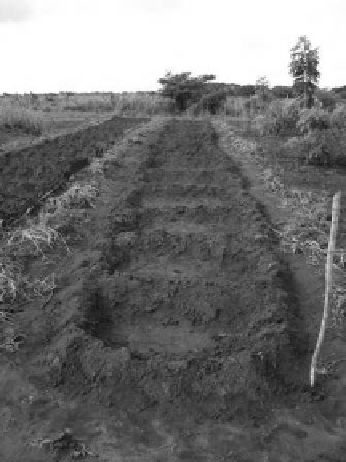Agriculture Reference
In-Depth Information
TABLE 12.7
Chemical Properties of Cutanic Acrisol (Hyperdystric, Arenic, Rhodic)
(Kanhaplic Haplustult) from Makonde Plateau in South Eastern, Tanzania
Horizon
Depth (cm)
pH H
2
O
pH KCl
OC (%)
N (%)
Av. P (mg/kg)
BS (%)
Ap
0-15
5.4
4.6
0.51
0.05
1.53
42
AB
15-47
5.5
4.5
0.24
0.06
0.53
36
Bt1
47-108
5.0
4.2
0.03
0.06
0.70
30
Bt2
108-200+
4.9
4.3
0.20
0.06
0.73
23
Source:
Kabanza, A. 2013. Insights into soil and water conservation measures for major land utilization
types in South Eastern Tanzania. PhD thesis. KU Leuven, Belgium. p. 166. With permission.
Note:
% BS, % base saturation; N, total nitrogen; OC, organic carbon.
generate significantly higher sediment yields, i.e., between 17 and 87 Mg/ha/year
(Table 12.8) (Isabirye et al. 2010). Other recent studies in the same area have dem-
onstrated further that settlement compounds and footpaths produced soil losses up
to 199 Mg/ha/year (De Meyer et al. 2011). Agricultural land use types produced
between 0 and 27 Mg/ha/year, with cassava generating the highest rates of 27.3 Mg/
ha/year in the Ugandan shoreline (Isabirye et al. 2010). Sediment yield from runoff
plots in the gardens on the Tanzania shoreline side were in a range of 1.2-22.7 Mg/
ha/year. Cotton, unlike cassava, in Uganda generated medium rates (12-25 Mg/ha/
FIGURE 12.1
Preparation of tied ridges (local CA practice in Makonde and Rondo pla-
teaus) for effective soil moisture storage and organic carbon conservation in Arenic Ferrasols
in southeastern Tanzania.





